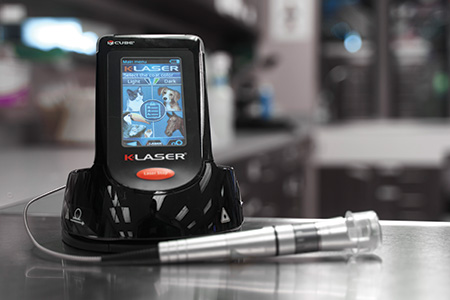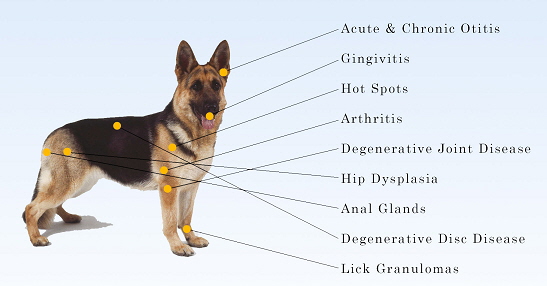Veterinary Laser Therapy
Overview of Veterinary Laser Therapy
Conventional Laser Therapy has been in use for more than 25 years. More than 3,000 scientific publications test its effectiveness and validity. It has been demonstrated that it is not toxic, and there are no known side effects. Today, it is used as a monotherapy or as a complementary therapy. Until now, the challenge with Laser Therapy has been its inability to treat deep-seated pathologies since it is used with low to medium power. We are pleased to provide our patients with the most advanced technology available today to leverage the benefits of laser therapy: MLS Harmony Laser Therapy.
MLS Harmony Laser Therapy
 MLS Therapy is a new therapy for treating pain, inflammation, edema, and repairing superficial lesions. It was developed to overcome the limits of traditional Laser therapy based on the use of diode lasers. Currently, no diode laser is able to induce strong anti-inflammatory, anti-edema, and analgesic effects simultaneously and within a short period of time. Continuous Laser emissions act fast on inflammation, stimulating blood and lymphatic circulation and inducing fast re-absorption of fluid build-ups. However, they only have a secondary effect on pain, which is diminished after reducing the inflammatory process. Pulsed Laser emissions, on the other hand, have an immediate impact on pain since they can produce analgesia, interfering with the very transmission of the pain impulse to the higher brain centers.
MLS Therapy is a new therapy for treating pain, inflammation, edema, and repairing superficial lesions. It was developed to overcome the limits of traditional Laser therapy based on the use of diode lasers. Currently, no diode laser is able to induce strong anti-inflammatory, anti-edema, and analgesic effects simultaneously and within a short period of time. Continuous Laser emissions act fast on inflammation, stimulating blood and lymphatic circulation and inducing fast re-absorption of fluid build-ups. However, they only have a secondary effect on pain, which is diminished after reducing the inflammatory process. Pulsed Laser emissions, on the other hand, have an immediate impact on pain since they can produce analgesia, interfering with the very transmission of the pain impulse to the higher brain centers.
The pulsed laser emissions are less effective at treating inflammation and edema, only achieving results after a long period of application. MLS Therapy is able to overcome the limits imposed by selecting one of the two emission types since it is based on the characteristic therapeutic properties of a new Laser pulse. It uses an MLS pulse, which combines and synchronizes the emission of continuous and pulsed Laser emissions with different infrared wavelengths. The patented control system that generates the MLS pulse synchronizes the two emissions.
Thanks to this characteristic synchronization, the various therapeutic effects – anti-inflammatory and anti-edema of the continuous emission and analgesic of the pulsed emission –take place simultaneously and reciprocally reinforce each other. Because of this, MLS therapy is able to guarantee effectiveness and short treatment times when treating numerous osteo-muscular system diseases and when repairing superficial lesions.
Clinical Benefits of Laser Therapy
Clients value the clinical benefits of Laser Therapy for veterinary care.
The benefits of laser therapy are relatively new in the veterinary industry. However, you can expect a marked improvement in your pet’s health, quickly and free of side effects from both chronic & acute issues. An example of chronic (long-term; ongoing) pain that can be improved is pain from arthritis. An example of acute (short-term; temporary) pain and/or swelling is that resulting from surgery.
MLS Harmony is the most advanced small animal laser on the market. The breakthrough of the multiwave system offers greater benefit to the patient than any one wavelength alone.
Benefits include intense anti-inflammatory and anti-edemic effects and also strong analgesic effects.
Quicker Recovery
As a result of all of the above, laser therapy provides the benefit you (and your loved pet) will appreciate the most: a quicker recovery.
Frequently Asked Questions
What are the most common indications for therapy?
The most common MLS Therapy indications are pain relief, intervertebral disc disease, post-surgical pain relief, degenerative joint disease, wound healing, arthritic conditions, muscular/skeletal system trauma, and inflammatory conditions.
What wavelengths are used in MLS therapy?
MLS therapy uses both the 808nm and 905nm wavelengths simultaneously. The 808nm wavelength is delivered using continuous emission, while the 905nm wavelength is delivered using pulsed emission.
Why are two wavelengths used?
MLS Therapy uses two wavelengths to overcome the limits of traditional Laser Therapy. Traditional veterinary laser therapy does not deliver both wave lengths in a reinforcing and synchronized fashion. Continuous laser emissions act fast on inflammation, stimulating blood and lymphatic circulation and inducing fast re-absorption of fluid build-ups. However, they only have a secondary effect on pain, which is diminished after reducing the inflammatory process. Pulsed laser emissions, on the other hand, have a practically immediate effect on pain since they can induce analgesia, interfering with the very transmission of the pain impulse to the higher brain centers. Still, they are less effective at treating inflammation and edema.
Is MLS Therapy approved by the FDA?
Yes, the FDA has approved the use of MLS therapy, and it is also patented via the U.S. Patent Office.
What is the advantage of MLS therapy over traditional low-level lasers? (LLLT)
MLS Therapy is able to induce strong anti-inflammatory, anti-edema, and analgesic effects simultaneously and within a short period of time. LLLT cannot achieve these results because of the limitations of using one or two wavelengths that are not synchronized. The patented control system that generates the MLS pulse synchronizes the emissions to achieve results previously unattainable. Thanks to this characteristic synchronization, the various therapeutic effects not only take place at the same time but reciprocally reinforce each other.
What is Harmony?
Harmony is the name of the laser used in the veterinary market that utilizes the patented MLS Therapy. The name was chosen because of the relationship between the two wavelengths and how they work together, much like a symphony, bringing different characteristics to the table and complementing the benefits of the other.
Is Harmony a class IV laser?
Yes, Harmony is a class IV laser with a peak power of 25 watts.
What is the depth of penetration of the Harmony laser?
The depth of penetration will vary based on the animal, but it is safe to assume that it will penetrate 4-5 cm on most animals.
How many treatments are usually needed to get results?
Results can often be seen after the first treatment. Most conditions have protocols that range from 6-10 treatments. The treatments are cumulative and are delivered 2-3 times per week for 2-3 weeks.
What is the cost of each treatment?
We offer both individual treatments and discounted packages. We also recommend post-surgical laser therapy at a discounted rate. Our veterinarians will be more than happy to evaluate which option would be best for your pet.
How was MLS Therapy developed and tested?
MLS Therapy has been developed and tested following a strict course of biomedical and clinical research. The effectiveness of the combination of the emissions making up the MLS pulse was initially tested in vitro on cellular cultures, then in vivo on animals, and finally by means of controlled clinical trials run by major state-of-the-art health organizations for treating traumatic and degenerative painful diseases.
Indications for Laser Therapy
LASER THERAPY is an advanced modality for treating Inflammatory and/or Painful conditions in dogs & cats.
 The most common Veterinary Laser Therapy indications are:
The most common Veterinary Laser Therapy indications are:
- Arthritis (Degenerative Joint Disease)
- Back Pain (Intervertebral Disc Disease)
- Trauma (Skin, Muscle, Bone)
- Wounds (Trauma)
- Surgery (Incisions, Growth Removals, Bone Surgery)
- Inflammatory Conditions:
- Acute or chronic otitis (Ear problems)
- Anal Gland inflammation
- Periodontitis (Gingivitis)
- Hot Spots
- Lick Granulomas
- Idiopathic Cystitis – (Bladder Inflammation)
- Sinusitis, Rhinitis (Nasal problems)


